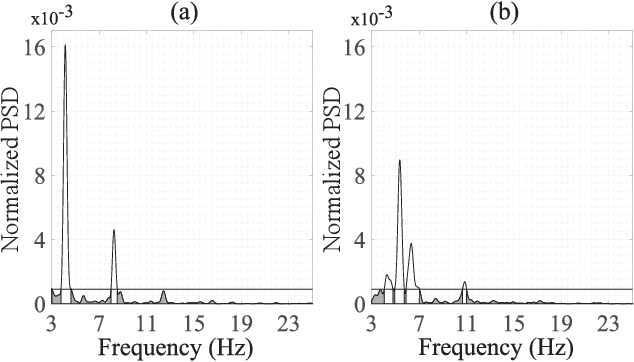Pilar Escribano
Combination of frequency-and time-domain characteristics of the fibrillatory waves for enhanced prediction of persistent atrial fibrillation recurrence after catheter ablation
Feb 04, 2024Abstract:Catheter ablation (CA) remains the cornerstone alternative to cardioversion for sinus rhythm (SR) restoration in patients with atrial fibrillation (AF). Unfortunately, despite the last methodological and technological advances, this procedure is not consistently effective in treating persistent AF.
Catheter Ablation Outcome Prediction With Advanced Time-Frequency Features of the Fibrillatory Waves From Patients in Persistent Atrial Fibrillation
Jan 19, 2024


Abstract:Although catheter ablation (CA) is still the first-line treatment for persistent atrial fibrillation (AF) patients, its limited long-term success rate has motivated clinical interest in preoperative prediction on the procedures outcome to provide optimized patient selection, limit repeated procedures, hospitalization rates, and treatment costs. To this respect, dominant frequency (DF) and amplitude of fibrillatory waves (f-waves) reflected on the ECG have provided promising results. Hence this work explores the ability of a novel set of frequency and amplitud f-waves features, such as spectral entropy (SE), spectral flatness measure (SFM), and amplitud spectrum area (AMSA), along with DF and normalized f-wave amplitude (NFWA), to improve CA outcome prediction. Despite all single indices reported statistically significant differences between patients who relapsed to AF and those who maintained sinus rhythm after a follow up of 9 months for 204 6 s-length ECG intervals extracted from 51 persistent AF patients, they obtained a limited discriminant ability ranging between 55 and 62%, which was overcome by 15 - 23% when NFWA, SE and AMSA were combined. Consequently, this combination of frequency and amplitude features of the fwaves seems to provide new insights about the atrial substrate remodeling, which could be helpful in improving preoperative CA outcome prediction.
Time Variability of FibrillatoryWaves Energy Predicts Long-Term Outcome of Atrial Fibrillation Concomitant Surgical Ablation
Jan 19, 2024Abstract:Surgical ablation (SA) is the most effective procedure to terminate atrial fibrillation (AF) in patients requiring concomitant open heart surgery. However, considering the great stress provoked in the patients heart, along with the benefits of anticipating antiarrhythmic therapeutical decisions, preoperative prediction of long term failure of the procedure is an interesting clinical challenge. Hence, the present work introduces a novel algorithm to anticipate SA outcome after one year of follow up by just analyzing the surface ECG. The method firstly extracts fibrillatory waves reflected on standard lead V1 using an adaptive QRST cancellation approach. The resulting signal is then segmented into 1 s length intervals and wavelet energy is computed for all of them. Finally, the coefficient of variation of the time series obtained for the 7th scale is computed. Analyzing 20 second length preoperative ECG excerpts from 53 persistent AF patients undergoing concomitant openheart surgery, only the proposed method reported statistically significant differences between the patients who relapsed to AF and those who maintained sinus rhythm during the follow up. The algorithm also provided values of sensitivity, specificity, and accuracy between 10 and 20% better than the well established dominant atrial frequency and fibrillatory waves amplitude, thus suggesting to be a promising predictor of AF recurrence after SA.
Spectral Distribution Complexity of the Surface Fibrillatory Waves Predicts Post-Catheter Ablation Relapse in Persistent Atrial Fibrillation
Jan 17, 2024

Abstract:As for most of cardiac arrhythmias, atrial fibrillation (AF) is primarily treated by catheter ablation (CA). However, the mid-term recurrence rate of this procedure in persistent AF patients is still limited and the preoperative prediction of its outcome is clinically interesting to select candidates who could benefit the most from the intervention. This context encouraged the study of C0 complexity as a novel predictor, because it estimates organization of the power spectral distribution (PSD) of the fibrillatory waves (f-waves). For that purpose, the PSD was divided into two divergent components using a threshold, theta, which was considered by multiplying the mean value of the PSD by a factor, alpha, ranging between 1.5 and 2.5. On a database of 74 patients, the values of C0 complexity computed for all alpha factors reported statistically significant differences between the patients who maintained sinus rhythm and those who relapsed to AF after a follow-up of 9 months. They also showed higher values of sensitivity (Se), specificity (Sp), and accuracy (Acc) than the well known predictors of the dominant frequency (DF) and f-wave amplitude. Moreover, the combination of the DF and the C0 complexity computed with alpha = 2, via a decision tree, improved classification until values of Se, Sp and Acc of 75.33, 77.33 and 76.58%, respectively. These results manifests the relevance of the f-wave PSD distribution to anticipate CA outcome in persistent AF patients.
 Add to Chrome
Add to Chrome Add to Firefox
Add to Firefox Add to Edge
Add to Edge